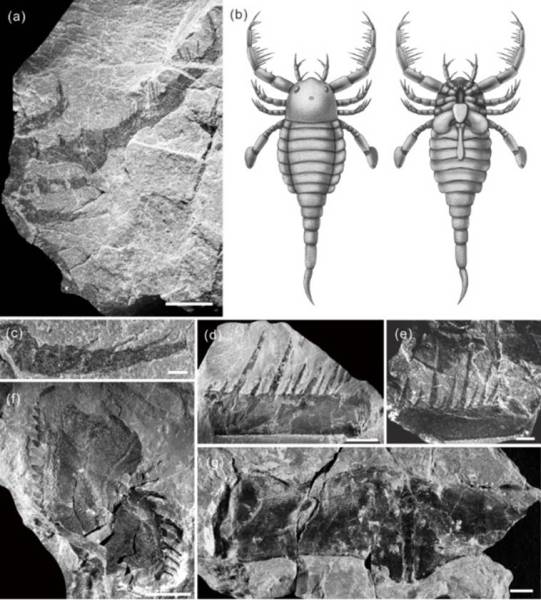
[ad_1]
Are you scared of the tiny five-inch scorpion? To further trigger your arachnophobia, meet the one-meter-long scorpion that ruled the South China sea about 400 million years ago.
Named Terropterus xiushanensis, it belonged to an extinct arthropod group called Eurypterids.
This group first appeared during the Ordovician age or 480 million years ago and reached its peak of diversity in the Silurian period (430 million years ago). The group went completely extinct by the end of the Permian era or about 280 million years ago.
Also read: Fossils reveal scorpion-like predator which ruled the seas 460 million years ago
The fossil was described from the Fentou Formation from Wuhan, Hubei, South China. The new species was seen to have special basket-like appendages for capturing its prey and so was placed under a group of eurypterids called mixopterids.
 a), c), d), e) and f) appendages of the scorpion; b) reconstruction drawing, dorsal and ventral views; g) genital operculum and the genital appendage
a), c), d), e) and f) appendages of the scorpion; b) reconstruction drawing, dorsal and ventral views; g) genital operculum and the genital appendage(NIGPAS)
“Our knowledge of mixopterids is limited to only four species in two genera, which were all based on a few fossil specimens from the Silurian Laurussia 80 years ago,” said lead author Han Wang in a release. She is from the Nanjing Institute of Geology and Palaeontology and Center for Excellence in Life and Paleoenvironment, Chinese Academy of Sciences.
The other four species of mixopterids were previously reported from Norway, New York, Estonia, and Scotland. This is the first record mixopterids from Gondwana. “Future work, especially in Asia, may reveal a more cosmopolitan distribution of mixopterids and perhaps other groups of eurypterids,” adds the paper recently published in Science Bulletin.
The new species had an enlarged limb and was characterised by a unique arrangement of spines. The team adds that this large arthropod may have played an important role as one of the top predators. By studying the difference in morphology, they hope to unravel the complex evolutionary history and relationship of this group.
[ad_2]
Source link